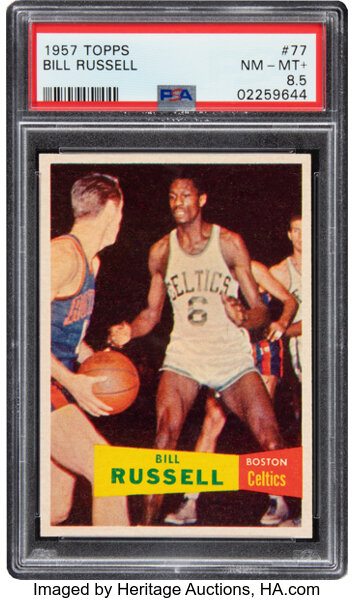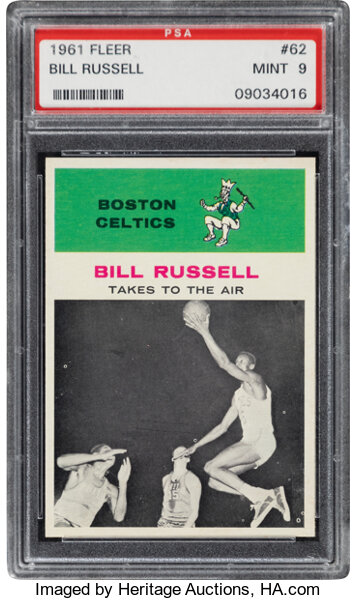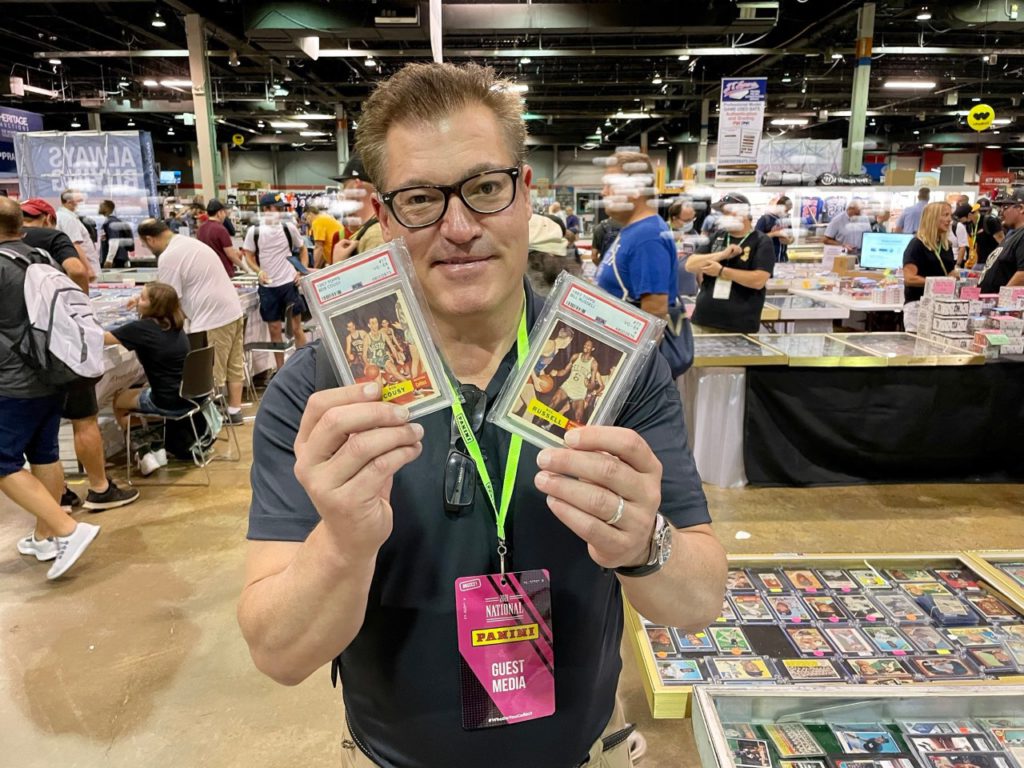Bill Russell is one of the most influential figures in the history of basketball, and he is now 88 years old. William Felton Russell was born February 12, 1934. His career as a center for the Boston Celtics from 1956 to 1969 is storied because many players had to change their game when playing against Russell and his 6′ 10″ frame and shot-blocking and rebounding skills. He won the NBA’s Most Valuable Player award 5 times and was a 12-time All-Star. And before joining the NBA he was on the U.S. Olympic team.
Every single vintage basketball card collector wants to own a Bill Russell card. In fact, every trophy-card collector should want to own a Bill Russell rookie card. There are just two small problems here. First and foremost is that there just aren’t that many Bill Russell cards to be bought. Second is that even the cards in lower conditions are going to cost you a serious premium.
Collectors Dashboard evaluates high-end collectibles as an alternative asset class. This means collectibles are attracting the same capital that could have been invested into stocks or bonds. In the case of Bill Russell’s cards from his career, these cards are generally in the thousands of dollars or tens of thousands if they are in great shape. Bill Russell is owed the story about why every vintage card collector, and probably anyone who is into basketball history, should want to own a Bill Russell rookie card (or at least a Bill Russell vintage card from when he was playing).
The number one 1950s rookie basketball card that is sought out by vintage collectors and investors alike is the 1957 Topps #77 Bill Russell. This is considered Russell’s official rookie card, and the set has frequently been referred to with 1958 in past references and sources. A prior small format card with a black and white photo from the 1955 All American Sports Club hand cut issue predated this rookie and the 1961 Fleer set has a Russell portrait and In-Action card. Here is why the scarcity is so strong — that is basically it for Bill Russell cards from his playing years. There are only a handful of basketball card sets that were printed by any major card company prior to 1970.
Card #77 of the 1957 Topps set is scarce, but does still have a large enough of a population that card sales occur regularly. That may sound like there is not a scarcity overall, but the demand greatly exceeds the supply for any graded Bill Russell cards with strong eye appeal. There is also overwhelming proof that Bill Russell’s rookie cards sell at a significant premium in any grade.
The Bill Russell 1957 Topps rookie card can easily command prices above $100,000 in the higher grades. These prices below are also after the card-buying mania that occurred in the first quarter of 2021:
- A PSA 7.5 sold for $150,000 via Robert Edward Auctions on December 6, 2021
- APSA 8 grade sold for $229,284.80 via Memory Lane on December 5, 2021.
- A PSA 8.5 example of Bill Russell’s rookie sold for $630,000 via Heritage Auctions on August 24, 2021 (image below by Heritage Auctions).

Two other PSA 8 examples (with different PSA certification numbers) were sold by Goldin Auctions earlier in 2021:
- 4/6/2021 sold for $399,750.00 in a PSA 8 via Goldin Auctions;
- 3/7/2021 sold for $346,860.00 in a PSA 8 via Goldin Auctions.
What is amazing is that two other PSA 8 examples sold via Heritage at prices that make you wish you use a time machine:
- 2/23/2019 sold for $24,000.00;
- 2/23/2019 sold for $38,400.00.
The PSA population report now versus last year will prove that this card has scarcity. Many modern basketball players saw their graded populations rise exponentially. That just isn’t true with the Bill Russell rookie, and collectors have known for years that if they have a rookie Bill Russell card they need to get it graded even in the lower conditions. PSA’s population report in April of 2021 counted just 719 base-grade examples, and in February 2022 the entire base-grade examples was just 771 cards. There are currently an additional 80 graded PSA cards with the “+” designations (.5 that is) and 177 graded with “Q” for qualifiers like OC/MK etc.
The largest grade population remains at PSA 4. This was just 177 PSA 4 grades for the “zone” last April and in February 2022 it is just 191 graded examples of the PSA 4 without an +/Q designation. In April of 2021 there were 119 PSA 5 examples and 153 PSA 6 examples, those were just up to 127 (PSA 5) and 157 (PSA 6). If you added 67 “+” grades and the 165 qualifier grades in April 2021 that was still a population of just 951 Bill Russell rookie cards in the entire PSA population report. Zooming to Feb. 2021 and the additional 80 “+” and 177 “Q” graded examples give an entire PSA population of just 1,028 graded examples.
So, despite all of the grading mania that took place in 2021, the PSA population growth of 951 total graded cards versus the entire 1,028 cards represents just 8.1% total PSA population growth. Try comparing that to LeBron James and Kobe Bryant rookie cards, or rookie cards of Luke, Giannis or Zion.
The SGC population report is listed as being in the 1957-58 Topps set. As of April 2021 it was also low at just 201 graded examples of the old and new grades combined. They only had 1 example at the SGC 96/9 level and 8 samples at the SGC 88/8 grade. The “in-the-zone” index here with the largest population is 46 graded samples at the SGC 60/5 level. Zoom forward to Feb. 2022 and the modernized graded population is just 215 cards for a total population growth of just 6.9%. The largest population now is 47 examples at the SGC 5 grade.
What does it mean when a PSA 4 and SGC 5 in the “Zone” spot for indexing purposes of 1950s cards? It means that the 1957 Topps set is known for being abusive to collectors. Topps was experimenting with the smaller cards after the 1956 Topps baseball set and after merging with Bowman. They were using printed photos as well and both the 1957 baseball cards and basketball cards were known for weak imaging. That is doubly true for the basketball set.
The PSA 4 (VG) graded samples sold in a range of $10,000 to $20,000 during the first 4 months of 2021. These were the last PSA 4 sales recorded by PSA itself:
- 01/17/2022 for $8,600.00 (eBay)
- 11/20/2021 for $8,400.00 (Heritage Auctions)
- 10/23/2021 for $7,988.00 (eBay)
- 10/13/2021 for $7,783.20 (Memory Lane)
- 07/26/2021 for $9,000.00 (Robert Edward Auctions)
Another issue in the 1957 Topps basketball set is that Topps almost went out of its way to prove that it just could care less about Card centering and the overall printing quality. That puts the Russell rookie card at a premium to most of the baseball Hall of Fame rookie cards that also suffer from centering and printing quality.
To further prove the point about quality and scarcity, PSA still counts only 47 PSA 8 examples without the 31 qualifier count and only 3 PSA 9s of any caliber. The number of PSA 10s is ZERO in the PSA population report. That is correct, no perfect grades have ever been found. Those higher “investor grades” have the exact same populations as a year ago. The reality is that there just are not many Bill Russell raw cards out there that have escaped being encapsulated by a grading company. Every collector now knows that these need to be graded, and you just never see a raw example at a sports card and collectibles convention.
Bill Russell’s stats as a player should easily compliment his rookie card stats. Russell played his entire professional career was with the Boston Celtics and the team won 11 championships in 13 years. This blew away what George Mikan accomplished with the Minneapolis Lakers in the prior years. Russell was a very physical player known for incredible defense, blocking and rebounding. His career average was 22.5 rebounds per game and he was the league leader in rebounds 4 times. He was the MVP 5 times and was an all-star in 12 seasons.
Many sports collectors who hunt trophy cards without digging through history first may have also overlooked that Bill Russell was an Olympic gold medal winner in 1956. Russell also had 2 NCAA championships with the University of San Francisco.
Joe Orlando’s 2002 book ‘The Top 200 Sportscards in the Hobby’ noted that Bill Russell’s legacy could not be measured by his statistics alone. The praise for this rookie card (and player) also noted that there would also be far fewer examples of the entire 1957 Topps basketball cards in general had it not been for a dealer discovery (find) of vending boxes. And even with that “find” many of those cards discovered still were not in great condition despite being sealed away for years.
1957 Topps Bill Russell cards do still come up for auction routinely. eBay generally always has one or two in auction format, and you will frequently find them listed as “Buy It Now” with excessive prices. Auction houses like Goldin, PWCC, Heritage, Memory Lane, Robert Edward and SCP frequently have a Bill Russell rookie as well.
And zooming forward a few years to the 1961 Fleer set just doesn’t give vintage sports collectors a massive population either. The only good news here is that the 1961 Fleer set offers the portrait and the In-Action shots. PSA’s total graded cards of all players in Feb. 2022 was 23,643 cards and the 1961 total PSAA graded card count of all players is still just 36,818 graded examples. The #38 portrait card has just 960 cards at base-PSA grades of all kinds (and No PSA 10 and just 29 PSA 9 and 164 PSA 8). These cards are also known for having severe off-centering issues. Russell’s #38 card has 54 “+” graded examples from PSA and 226 “Q” graded examples, giving the 1961 Fleer card population a total of 1,240 in all PSA graded and qualifiers (versus just 1,028 total PSA graded examples for the 1957 Topps).
The 1961 Fleer #62 Bill Russell In-Action card has 718 base PSA graded examples, again with no PSA 10 to be found. Add in 25 “+” and 166 “Q” and the total “In Action” PSA graded population is just 909 examples. A PSA 9 of the 1961 Fleer In-Action card sold for $13,800.00 on May 6, 2021 via Heritage Auctions (image below by Heritage Auctions).

All in all, this leaves well under 5,000 total graded examples of vintage Bill Russell cards for vintage sports card collectors to fight over. It is also easy to assume that at least half of those cards simply will not come out of collections either, leaving only dealers looking for a margin and collectors who just cannot refuse the urge to sell for future opportunities to buy a vintage Bill Russell card.
There are many reprint cards of Bill Russell with an autograph on them, as well as other memorabilia items. There just are not that many vintage basketball cards for collectors who want to own a piece of Bill Russell’s cardboard treasure history.
Every vintage sports card collector and sports card investor now hopefully now knows why the Bill Russell rookie card from the 1957 Topps set is a must-own treasure. Too bad this graded 1957 Topps set (below) got away at the National Sports Collectors Convention in 2021.

Categories: Basketball, Sports


